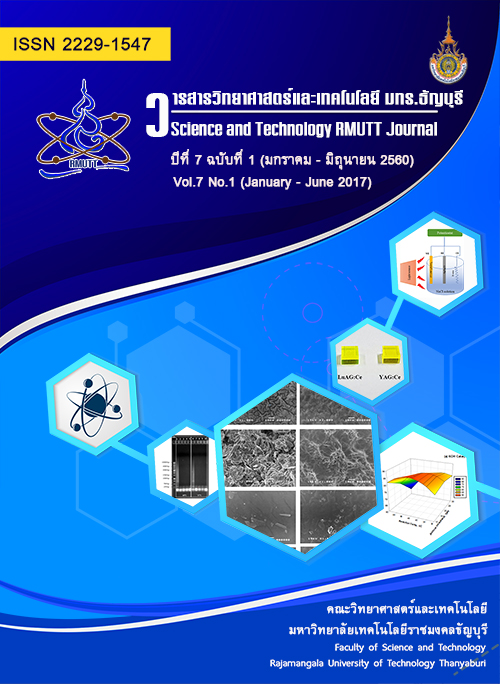Effect of Clove Flower and Leaf Extracts on Sedation in Hybrid Catfish
Main Article Content
Abstract
The extracts from cloves (Syzygium aromaticum (L.) Merr. & L.M.Perry) flowers and leaves are widely used in dental care as an antiseptic and analgesic agent due to its antibacterial effect against a large number of bacteria. The aims of this study were to: (1) reveal the chemical composition of clove flower and leaf extracts using GC-MS. and (2) evaluate the sedative and anesthetic effects of the extracts on aquaculture transportation. The juvenile catfishes with an average length of 7-10 cm and average weight of 8-12 g, and four extracted sample concentrations of 50, 100, 150 and 200 mg/L were used to assess the induction time from sedation and recovery. The chemical composition identified using GC-MS analysis comparing with pure eugenol, a standard agent revealed that eugenol was a major constituent of the extracts. It was 79.62% from leaf extract followed by 62.53% from flower extract. Clove flower extract induced sedation of hybrid catfish at 20.17 ± 0.0.970, 13.33 ± 0.516, 4.67± 0.516, 3.33± 0.258 min, respectively. The recovery of hybrid catfish showed of 67.50 ± 0.880, 48.67± 0.931, 67.50 ± 1.696 and 112.50 ± 1.754 min, respectively. Clove leaf extract induced sedation of hybrid catfish at 37.83 ± 0.585, 22.33 ± 0.931, 20.83 ± 0.585, 17.17 ± 0.585 min, respectively. For the recovery of hybrid catfish showed of 2.806 ± 1.204, 3.557 ± 0.914, 56.33 ± 1.125, and 70.83 ± 0.917 min, respectively. In addition the optmal concentration producing total loss of balance and response to external stimuli with shorter induction time was the flower extract fallowed by leaf extract at 50 and 100 mg/L with a duration time of 20.17 ± 0.970 and 22.33 ± 0.931 min, respectively.
Article Details
References
FAO. 2012. The State of World Fisheries and Aquaculture. UN, Rome, Italy. 230 pp.
นาวิน มหาวงศ์, เมธาคชาภิชาติ, ปฏิพัทธ์อภิธนกุล และประโยชน์ บุญประเสริฐ. 2549.กานพลูพืชสารพัดประโยชน์และการทดลองเบื้องต้น ในการใช้น้ำมันกานพลูเป็นยาสลบในปลาน้ำจืด สำคัญทางเศรษฐกิจบางชนิด. วารสารการประมง 59:524-532.
ดนัย สมใจ อรอุมา พาลเสือ และสมหมาย เชี่ยววารีสัจจะ. “ความเป็นพิษและประสิทธิภาพของน้ำมันกานพลูในการสลบปลากัดจีน,” วารสารมหาวิทยาลัยทักษิณ. 11 (2), 2551 : 30-38.
Raina, V.K., Srivastava, S.K., Aggarwal, K.K.,Syamasunder, K.V. and Kumar, S. “Essential oil composition of Syzygium aromaticum leaf from Little Andaman, India,” Flavour and Fragrance Journal, Vol 16, 2001. pp 334-336.
Alma, H., Murat, E., Nitz, S. and Kollmannsberger, H. “Chemical composition and content of essential oil from the bud of cultivated Turkish clove (Syzygium aromaticum L.),” Bioresearch, Vol 2 (2), 2007. pp 265-269.
Banker, R., Kumer, A. and Puri, S. “Phytochemical constituent of Syzygium aromaticum L.,” International Journal of Current Research. Vol 3 (7), 2011. pp 215-217.
Wooster, G. “Fish and Amphibian Anesthasia,” Animal Care and Use Committee. Vol 110 (1), 2011. pp 1-5.
Brown, L.A. and Stoskopf, M.K. “Anesthesia and Surgery,” Fish Medicine, 1993. pp 79-90.
Velisek, J., Svobodova, Z., Piackova, V., Groch, L. and Nepejchalova. “Effects of oil anaesthesia on common carp (cyprinus carpio L.),” Veterinary Medicine-Czech. Vol 50(6), 2005. pp 269-275.

